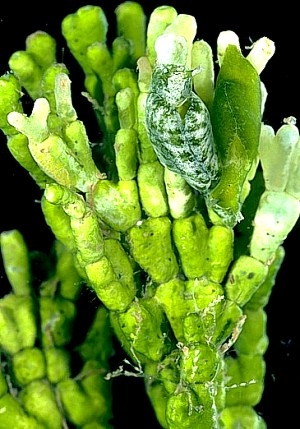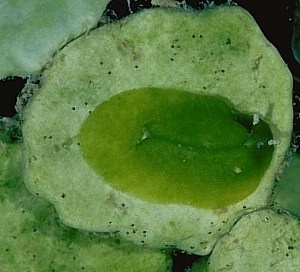

Halimeda spp.
Phylum: CHLOROPHYTA
Order: BRYOPSIDALES
Family: Udoteaceae
PHOTO
Koumac Beach (=Baie de Ouanap), near Koumac, New Caledonia, in mixed grassbeds. Two 'forms' or species of Halimeda. October 1993, with Elysiella pusilla. Photos: Bill Rudman.
Halimeda is a genus of green algae, with mnay species in tropical waters worldwide. It is easily recognised by its shape, which consists of calcified segments, connected to each other by very narrow points. The segments are usually very flattened, but in some species, as illustrated here, they can be more rounded and cylindrical. Each plant is attached to the substrate by a stalk and holdfast, or in the case of species living in sand or unstable sediment, the stalk forms a swollen bulb to anchor the plant.
As well as calcification, species of Halimeda are protected, to some extent, from herbivorous animals by the presence of diterpenoid metabolites. These chemicals do not deter some sacolglossans from feeding on species of Halimeda, and in the case of at least one species, Elysiella pusilla [see message #2361], eats Halimeda, and it incorporates the metabolites into its own tissue for its own defence.
Halimeda is closely related to Penicillus, another genus preferred by some sacoglossans.
Authorship detailsRudman, W.B., 2007 (January 29) Halimeda spp.. [In] Sea Slug Forum. Australian Museum, Sydney. Available from http://www.seaslugforum.net/factsheet/halimeda
